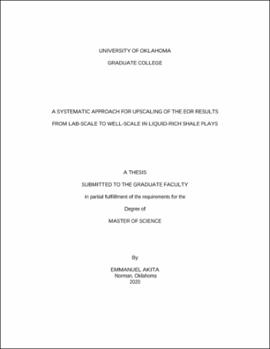| dc.contributor.advisor | Moghanloo, Rouzbeh | |
| dc.contributor.author | Akita, Emmanuel | |
| dc.date.accessioned | 2020-07-31T15:37:44Z | |
| dc.date.available | 2020-07-31T15:37:44Z | |
| dc.date.issued | 2020 | |
| dc.identifier.uri | https://hdl.handle.net/11244/325342 | |
| dc.description.abstract | Breakthrough technologies such as horizontal drilling and hydraulic fracturing have led to game-changing results in the oil and gas industry. With the increase in energy demand and the overall growth in oil production in the United States, unconventional resources have become extremely attractive to exploit this end. The breakthrough technologies help make possible the exploitation of resources from tight plays since their characteristic low permeability and low porosity have made them previously uneconomic. Well stimulation and completion technologies have been researched and improved over the past few decades as scientists and engineers aim to increase the production of hydrocarbons from hydraulically fractured wells.
This thesis explores equations to describe recovery factors of EOR processes in oil shale plays. The existing studies imply promising future for implementing gas cyclic injection through hydraulically fractured wells completed in shale plays; the EOR agent (a mixture of HC gas or CO2) is injected and after a soaking period, the well is put back on production. However, translation of lab-scale EOR results to field-scale is yet to be resolved. Dynamic penetration volume (DPV) controls the amount of contacted oil by the EOR agent (fluid-fluid interface) and slowly grows with the square root of time, and limits the recovery efficiency in the pilot-scale. The main idea proposed in this thesis is developing a systematic approach to upscaling the EOR recovery in lab-scale to field-scale. Modeling and experimental methods are used to investigate potential recovery loss in well-scale compared to recovery measured in the lab-scale. In this formulation, the recovery in pilot-scale is defined as the product of recovery in lab-scale and field factor. Recovery in lab-scale is a function of pressure drawdown during production (choke effect). Choke-size controls how fast the mixture of gas and vaporized oil components will be produced back after soaking time.
The field factor entails two parameters that control how much of in-situ liquid hydrocarbon can potentially interact with EOR agen. It is evaluated as the fraction of reservoir volume prescribed within inter-well spacing accessible to the EOR agent when injection process begins. The pore connectivity loss can occur because of the physical closure of flow path at the fracture-matrix interface and/or two-phase blockage. The limiting two phase phenomena can potentially prevent the injected gas from getting into pore space because of capillary forces.
The results suggest that recovery in the pilot-scale can be significantly reduced owing to pore connectivity loss (a factor of two). The pore connectivity is reduced as pore pressure decreases and effective stress increases. Change of fluid conductivity is evaluated under stress and differentiate contribution of pore connectivity loss and pore shrinkage. Also, the concept of Biot number is introduced, which lumps together all parameters unaccounted for on the field scale, and thus helps to use similar equations at different scales, providing a systematic approach. Moreover, the results suggest that chokes size effect observed in the experiments can be explained by loss of pore connectivity. Finally, field factor values are calculated and determined as being between 0 and 1. | en_US |
| dc.language | en_US | en_US |
| dc.rights | Attribution-NonCommercial-NoDerivatives 4.0 International | * |
| dc.rights.uri | https://creativecommons.org/licenses/by-nc-nd/4.0/ | * |
| dc.subject | Upscaling | en_US |
| dc.subject | EOR in Shales | en_US |
| dc.subject | Field Factor | en_US |
| dc.title | A SYSTEMATIC APPROACH FOR UPSCALING OF THE EOR RESULTS FROM LAB-SCALE TO WELL-SCALE IN LIQUID-RICH SHALE PLAYS | en_US |
| dc.contributor.committeeMember | Tinni, Ali | |
| dc.contributor.committeeMember | Mohammadzadeh, Omidreza | |
| dc.date.manuscript | 2020 | |
| dc.thesis.degree | Master of Science | en_US |
| ou.group | Mewbourne College of Earth and Energy::Mewbourne School of Petroleum and Geological Engineering | en_US |
| shareok.orcid | https://orcid.org/0000-0001-5579-888X | en_US |
| shareok.nativefileaccess | restricted | en_US |

